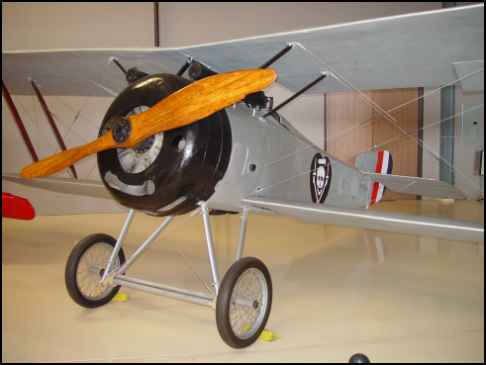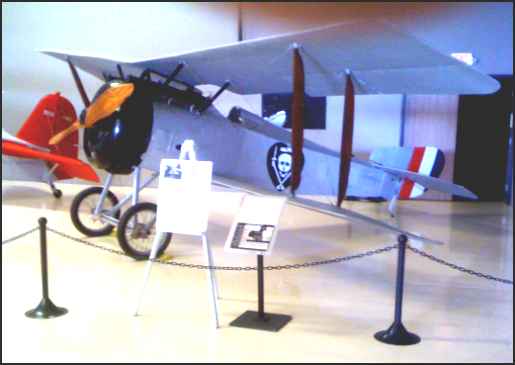
Chino, CA |
 |
On Display at the Planes of Fame Air Museum Chino, CA, 8-7-09 |
|
Charles Nungesser, called the "Iron Man" of the French Air Service in World War I,
was one of the most reckless and courageous of all the flyers who took part in that aerial age, 1914-1918. By
all accounts, those who knew him declared him to be a "fine fellow and an ecellent pilot." His bravery and
skill as a pilot are attested to by his record of 45 enemy aircraft downed in action. That he lost his life in
a peacetime attempt to cross the Atlantic by air, but a few days before Lindbergh won the Orteig Prize, was
just one more episode in a very daring lifetime, but a great loss to the flying profession. The airplane which Nungesser brought to this country following the War, for exhibition purposes, is still in existence, having been located, restored, and placed in the Air Museum in Claremont, California, by the author. It is the same plane used by Nungesser in scoring many of his e.a. destroyed, and this type was also used by the Belgians and Italians during the War, and by the United States Navy during and after the War. It is the Hanriot HD-1. Nungesser came to be known as the "Iron Man" because of the many injuries he sustained in combat and crash landings while in the Air Corps. In all, he was wounded seventeen times, and his airplanes were severely damaged innumerably. He was awarded many decorations and at war's end, was the third ranking French flyer of the War in numbers of the enemy downed. In 1925 Nungesser and two other French pilots brought the Hanriot of this story, and a Nieuport 18 and a Potez, to the United States to embark on a barnstorming career lasting nearly three years, doing stunting at county fairs, air races, and wherever crowds could be gathered together for charter flights or dollar rides. In 1925 Nungesser took part in the first aviaiton motion picture thriller made foll\owing the Great War. It was "The Sky Raider," and both Hanriot and the Nieuport were used. When the picture was completed, Nungesser arranged to travel with it on a nation-wide tour from New York to San Diego, doing stunts every day over the city where the picture was being shown, to attract attention to |
BY ED MALONEY The tour almost ended at Denver, Colorado, when a weld broke loose at the motor mount and the airplane began to shake violently. Nungesser landed safely, but the tour was interrupted and the Hanriot was shipped on to Santa Monica, California. There it was repaired in the shop of A. J. Montee at Clover Field. After his airplane was repaired, Nungesser continued stunting each day over the Pantages Theatre in Hollywood until the end of the picture's showing. The Hanriot was left in the care of Mr. Montee at Clover Field while Nungesser went of to plan for his trans-Atlantic flight in the spring of 1927 with Major Francis Coli. For their oceanic attempt, then becoing the goal of many a professional pilot, Nunbesser and Coli obtained a Levasseur biplane which they prompt5ly named the "Oiseau Blanc" or "White Bird." It had a 450 hp Lorraine-Dietrich engine and they equipped it with the best instruments and flying gear of that day. On May 9, 1927, Nungesser and Coli took off from Paris, attempting the East-West crossing of the Atlantic, just twelve days before the Lone Eagle made his successful crossing from West to East. The "White Bird" was last sighted at 11:00 A. M. off the coast of Ireleand and the flyers were presumed lost at sea. Nungesser's Hanriot Scout was auctioned off some time later to pay the storage bill then due, and was bought by Jim Granger, who flew the airplane from time to time in various motion pictures which were then being filmed in Southern California. It was flown in both "Wings" and "Hell's Angels" and at the premier of the latter picture was placed on display at the front of Grauman's Chinese Theatre in Hollywood. Following this, the airplane was kept in a hangar at Clover Field for several years, where the kids and other curious could walk up to it and speculate on its past history and thwe unique insignia carried on the side of the fuselage. This insignia had become Nungesser's during the War when he learned that a reward had been offered for his death or capture by |
the Germans. It was a sort of reply to this and each of the items had a special significance to Nungesser. On a large black heart there were the familiar skull and bones, and also two burning candles and a coffin. The insignia was painted on all of his latter wartime aircraft, his barnstorming planes after the War, and really came to prominence in the publicity attending his trans-Atlantic attempt. The Hanriot that was Nungesser's was placed in storage by Mr. Granger in 1933, where it remained until February, 1951, when the author sought it out and purchased it from Mrs. Granger. It has been restored and is now in the Air Museum in Chino. Specifications: Span, upper 28'-6 1/2" lower 24'-3" Chord, upper 4'-1" lower 3'-10 1/2" Length 19'-6" Height 9'-8" Engine - 110 HP LeRhone Rotary Weight, empty 1021 lbs. gross 1605 lbs. Service History: Apparently Nungesser shared the same regard for the Hanriot as other pilots who had actually used this type in wartime service - the regard for a fine horse. Major Willy Coppens described it thusly: "I fell in love with the Hanriot at first sight. It was as light as a feather on the controls and the pilot had a wonderfully clear field of vision. Although my first flight on the machine was made in extremely bad weather, I landed it perfectly,....and was delighted with it....It was strong in spite of its apparent fragility, and was faster and climbed better than the Nieuport." The Hanriot HD-1 came into service in mid-1917 with the Belgian Flying Service and the Italian Air Service, and in very limited use with the French, in whose country it was produced. The United States Navy procured from the French a number of Hanriots which were used at Naval Stations on the French coast, and reconstructed ten HD-1's at the Naval Aircraft Factory, Philadelphia, after War's end. The Naval Hanriots were used for pilot training for several years after the War. |
 |
Taken at the Planes of Fame Air Museum Chino, CA, by the webmaster, Ralph Cooper |
|
Chino, CA "Planes of Fame Air Museum is an independently operated, non-profit 501(c)(3) aviation museum dedicated to collecting, restoring, displaying, and preserving aircraft and memorabilia for the educational benefit of current and future generations. The Planes of Fame Air Museum was the first permanent air museum west of the Rocky Mountains. It officially opened to the public in January 1957 with an initial collection of six aircraft. Currently, Planes of Fame houses over 150 aircraft at its two locations, the main facility at Chino Airport in California and a satellite museum near the Grand Canyon at Valle Airport in Arizona. We invite you to take a look around the Planes of Fame Air Museum website to learn more about the museum and how you can be a part of preserving aviation history." |


|